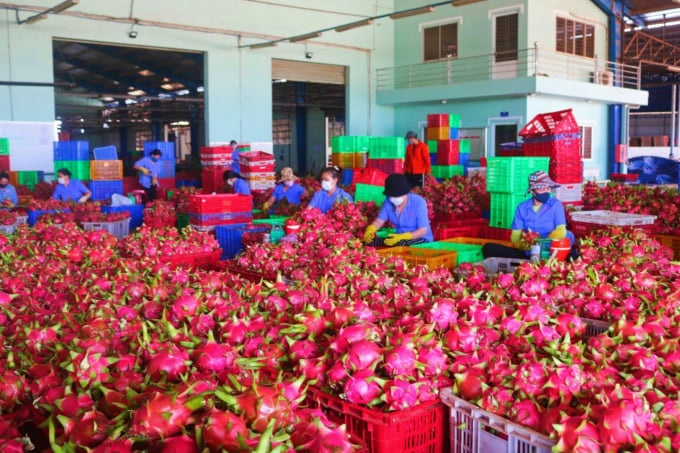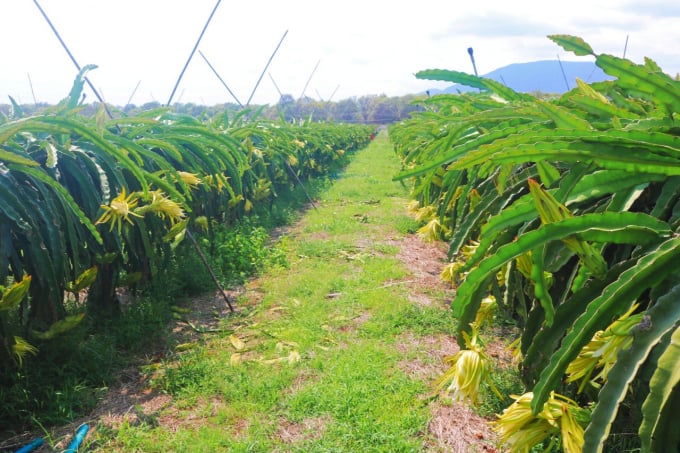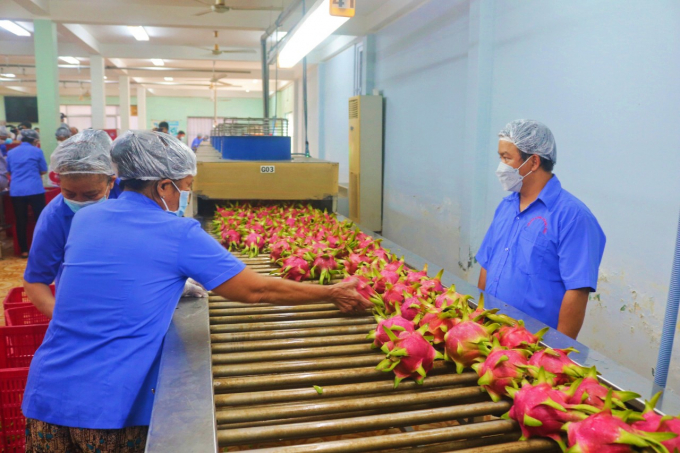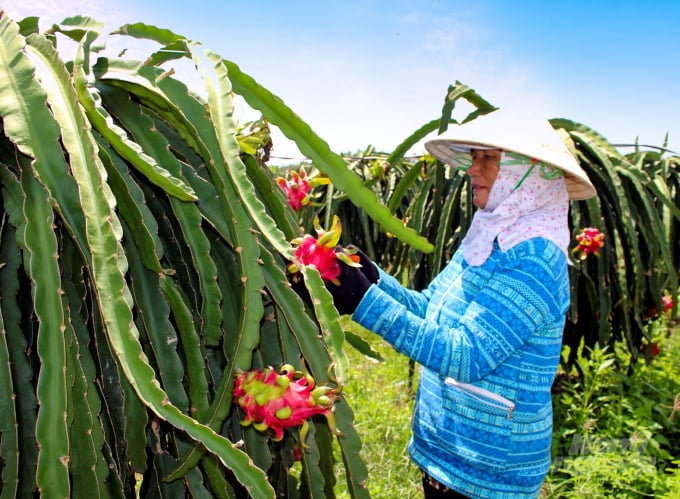November 21, 2025 | 22:39 GMT +7
November 21, 2025 | 22:39 GMT +7
Hotline: 0913.378.918
November 21, 2025 | 22:39 GMT +7
Hotline: 0913.378.918
Addressing at a recent conference on the production and consumption of dragon fruit held by the Ministry of Agriculture and Rural Development (MARD) in Binh Thuan Province, Deputy Director of the Plant Protection Department Le Van Thiet said that the negotiation of exporting dragon fruit to the US from Vietnam initiated by the unit in 2014 under the direction of the MARD.

The exportation of dragon fruit to the Chinese market as well as to other countries demands planting area and packing facility codes. Photo: KS.
After the US market, Vietnamese dragon fruits have also been exported to many other strict ones like Japan, South Korea, Australia or New Zealand.
On January 1, 2019, the General Department of Customs of China announced the demand for codes of planting areas and packaging facilities to nine types of Vietnamese fruits exported to the country.
According to Thiet, Vietnam now has 3,646 planting area codes, 1,800 packing facility codes for all kinds of fresh fruit for export, and 50/63 provinces/cities having been granted planting area codes.
Particularly, three provinces - Binh Thuan, Long An and Tien Giang – currently have 292 planting areas and 1,100 packing facility codes granted to a total area of about 44,231 hectares. The dragon fruit planting area and packing facility codes therefore have well met the export needs of enterprises to China and other markets.
Previously, the granting of the codes was assigned to the Plant Protection Department by the MARD. However, due to the increasing demand for the codes as requested by the Chinese side, the granting of codes has been assigned to locality as well.
It means that the receipt of dossiers, inspection, verification and issuance of planting area codes are conducted by local Sub-Departments of Crop Production - Plant Protection. After that, the sub-departments transfer the dossiers to the Plant Protection Department before they are sent to importing countries. As soon as these markets approve the applications, they will be sent to localities for management.

Currently, the planting area and packing facility codes have been assigned to localities for management. Photo: KS.
In Binh Thuan Province, dragon fruit is identified as a local key plant and specialty.
According to the provincial Department of Agriculture and Rural Development, the locality has a total area of 33,750 hectares growing dragon fruit with an output of 700,000 tons/year, 12,397 hectares of which have been certified with VietGAP, accounting for 35% of the total area of dragon fruit in the province. Another 355 hectares of dragon fruit in the area have been granted GlobalGAP Certificate.
However, it is necessary to have a planting area code before exporting to meet the requirements of dragon fruit importing countries.
Over the past time, the Provincial People's Committee has directed the agricultural sector to support farmers in implementing the regulations in good agricultural practices (GAP) to ensure product safety and quality; occupational health, safety, environmental protection and traceability.
Binh Thuan has asked the Plant Protection Department to grant 396 planting area codes and 268 codes for packing facilities for dragon fruit to export to China and other markets.

Vietnamese dragon fruit is mainly exported to China. Photo: KS.
In addition, Binh Thuan Plantation and Plant Protection Sub-Department conducts inspection to issue codes to 21 growing regions for white-fleshed and red-fleshed dragon fruit products exported to the South Korean, the US, Australia, New Zealand, China and 4 packing facilities for export to the Chinese market in 2021.
The inspection showed that all of these growing areas and packing facilities met the requirement. Of which, 17/21 growing areas have been granted codes while 4 growing areas and 4 packing facilities are waiting for approval from the importing country.
At the same time, Binh Thuan Plantation and Plant Protection Department supervised 128 growing areas for white-fleshed dragon fruit and red-fleshed dragon fruit exported to Korea, the US, Australia and New Zealand. Among them, 24 growing areas met the requirements; 91 planting areas did not meet the requirements; 13 planting areas proposed to cancel the code and 6 planting areas to change planting area information.
In addition, two facilities that pack dragon fruit products for export to the Chinese market were supervised, of which 1 code has been revoked and another has been canceled.
According to Do Van Bao, Director of Binh Thuan Plantation and Plant Protection Sub-Department, the complicated situation of the Covid-19 pandemic in 2021caused many difficulties in the inspection and supervision of granting codes to growing areas and packing facilities in the province.

The issuance, use and management of growing area and packing facility codes demand stricter regulations and sanctions. Photo: NNVN.
In addition, the Department of Plant Protection has not yet issued a guiding document on handling violations in case organizations and individuals counterfeit the official codes for growing areas or packing facilities.
Therefore, the Binh Thuan Sub-Department of Cultivation and Plant Protection has requested the issue of a decree detailing the implementation of Article 64 of the Law on Cultivation as well as a circular guiding the grant and management of codes.
At the same time, regulations on handling administrative violations in the use of growing area and packing facilities codes as well as product traceability should be supplemented.
The unit also called for strict management of export shipments in terms of plant quarantine and food safety, ensuring that their origins are equivalent to the growing area and packing facility codes.
Translated by Phuong Ha
/2025/11/21/4309-2-153400_128.jpg)
(VAN) Green and low-emission rice is paving the way for Vietnamese rice to enter high-end markets, marking the beginning of a transformation journey toward greening and elevating the national rice brand.

(VAN) ‘Right to Win’ outlines a national action plan that shapes a new vision for Viet Nam’s agriculture in an era of renewal and global integration.

(VAN) Lam Dong’s farmed sturgeon output this year is expected to reach 2,300 tons, worth VND 450 billion, affirming the brand’s position on the market.

(VAN) A surge in Ukrainian egg exports, largely driven by soaring sales to the UK over the last few years, has notably pushed up egg prices on the domestic market.

(VAN) The price of Arabica Catimor coffee in Quang Tri is currently at VND 25,000–27,000/kg (fresh cherries), the highest level ever recorded

(VAN) 'From the coffee story, we can think deeper and further about the crop production sector - from development orientations and value-chain organization to international integration,' assessed Dr Le Quoc Doanh.
/2025/11/18/2431-0-161627_248.jpg)
(VAN) Viet Nam accounts for 43% of the world's export volume of Robusta coffee. However, the Vietnamese Robusta coffee brand has yet to gain broad recognition on the global market.